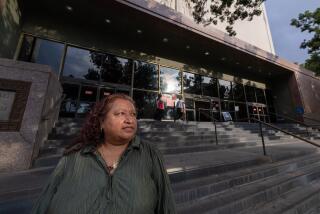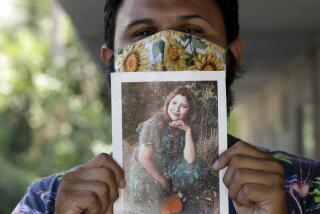Talk Is Cheap, and Also Valuable : Dispute Resolution Process Gains Popularity by Avoiding High Cost of Long Legal Battles
SOUTHEAST AREA — In February, 1991, after a Compton police officer killed two Samoan brothers while investigating a domestic disturbance, Samoan tribal Chief Tua’au Pele Faletogo knew he had to act fast.
Samoans were “getting ready to burn down Compton,” said Faletogo, who summoned other matais , or chiefs, for an emergency meeting.
The chiefs faced a dilemma: How could they demand justice for what the Samoan community perceived as a grave affront without inciting more violence?
“The Polynesian way is that we talk things out,” said Faletogo, who contacted the Asian Pacific American Dispute Resolution Center in downtown Los Angeles for help. “People were very upset, and I knew there would be a lot of people hurt unless we resolved it in a peaceful way.”
After two years of mediation with representatives of the dispute resolution center and the U.S. Department of Justice, the two parties finally reached an agreement recently. The city of Compton agreed to hire four people to establish programs dealing with such issues as police brutality and the city’s minority-hiring practices.
The case had already been through the courts. In May, 1992, a jury deadlocked in favor of acquitting Alfred F. Skiles Jr., 44, of shooting Pouvi and Itali Tualaulelei a total of 19 times, mostly in their backs. Prosecutors sought to have Skiles retried on two counts of voluntary manslaughter in the deaths, but in June a Superior Court judge refused to order a new trial. Skiles took a medical retirement from the force, citing stress. The outcome of the case enraged the Samoan community.
As the public has grown increasingly unhappy with the time and money required to send a case through the judicial system, many individuals, groups and businesses are trying other ways to resolve their problems.
“Most of us raised in the United States believe that if we have an issue, we take it to court,” said Dennis Westbrook, project director of the Martin Luther King Jr. Dispute Resolution Center, which serves South-Central Los Angeles and surrounding communities. “But if we change our mind-set around and try collaborative decision-making, we’ll be better able to work out solutions to our problems.”
Alternative dispute resolution provides an opportunity to work out an agreement with the help of a trained mediator, conciliator or arbitrator. Both parties must agree to participate.
In mediation, disputants usually meet face to face to resolve their problems at a neutral site. During conciliation, both parties meet individually with a conciliator, who tries to work out a mutually acceptable agreement. Arbitrators hear testimony and then render a judgment.
Through mediation, Crenshaw resident Nora Clay was able to resolve a dispute with a mechanic over the work he had done on her 1985 Cadillac this year.
“The man fixed my car transmission, but it still didn’t run good,” Clay said. “It broke down, and I had to get it towed.”
After a mediator from the city attorney’s office stepped in, the mechanic agreed to refund Clay the $1,000 she paid him.
“That lady,” Clay said of the mediator who handled her case, “boy, she could take care of business. Lord, if we had those kinds of lawyers, the world would be so sweet.”
Although Faletogo, the Samoan chief, said he was satisfied with the agreement that was reached with the city of Compton, he said reaching it was very frustrating.
After Officer Skiles shot Pouvi and Itali Tualaulelei “there were hard feelings on both sides,” Faletogo said. “The people from the city were on the defensive, and the meetings were hitting a cement block,” he said.
However, Compton City Manager Howard Caldwell said he never regarded the issues being discussed during mediation as disputes.
“We just wanted to improve the channels of communication, and the process of having a third party just facilitated that,” Caldwell said.
Taxpayer-financed dispute resolution services began in 1986 when a new state law allowed counties to increase civil court filing fees by $3 to fund the programs.
Los Angeles County now operates 11 centers and charges as much as $50 an hour, depending on the income of the client and the nature of the dispute.
For example, the Dispute Resolution Service for the Long Beach Courthouse helps resolve matters that are referred by judges. If a dispute has not reached court, it would probably be handled by the Community Mediation Program in Lakewood.
Although more people are using alternative dispute resolution to resolve such issues as landlord-tenant disagreements or roommate problems, officials say budget cuts are jeopardizing the county’s programs.
Since 1990, the county’s dispute resolution budget has been slashed 40%, from $2.5 million to $1.5 million, according to county figures. Officials at the county-funded agencies, which resolved more than 6,100 cases last fiscal year, say the budget cuts are forcing them to turn away clients because the agencies do not have the staff to process all the requests.
“What’s going to happen is that there will be a continual decrease in services at a time when services are needed more than ever,” said Lauren Burton, executive director of the Los Angeles County Bar Assn.’s Dispute Resolution Services. “Everyone says how wonderful these services are and how much they save money . . . but nobody wants to pay for it.”
Dispute resolution centers have been forced to cut their budgets because the county initially overestimated the amount of revenue it could draw from the additional $3 court filing fee. Although the county estimated revenues of about $2.5 million, it collects about $1.5 million annually, said Henry Knawls, the county’s division chief of community service. “We were too optimistic,” Knawls said. “But instead of reducing the budget all at once, we did it incrementally.”
About 60% of the cases that the eight county-funded agencies handle are resolved, Knawls said. Some problems are resolved in an hour; others are discussed for months.
“The hardest cases to resolve are those between neighbors and family members because the animosity has built up,” said John Haynes, a mediator with the Los Angeles County Department of Consumer Affairs dispute settlement services. “It’s not just the issues, it’s all the problems that have built up over the years.”
Mediators say one of the biggest challenges is getting both parties to participate. Since mediation is voluntary, if one side chooses not to participate, the case ends there.
Westbrook said it is often difficult for his agency to persuade people to participate in the process because it “has been foreign to the majority of inner-city residents.”
However, Westbrook and Marcia Choo, program director of the Asian Pacific American Dispute Resolution Center, said alternative dispute resolution can play an important role in preventing violence, particularly among people of different ethnic groups.
“People are angry, and there’s a lot of antagonism out there,” Choo said. “It’s naive to think that mediation can solve ethnic problems, but this multicultural collaboration at least is chipping away at the problem.”
Choo said she often handles cases that deal with cultural misunderstandings. When people of different ethnicities are disputing, Choo said, she will try to call in a mediator of each ethnicity to make both sides feel comfortable.
“Most disputes are not about the money,” Choo said. “It’s about honor or someone feeling offended by someone else. Mediation deals with emotions and feelings, and a lot of times, people are simply looking for an apology.”
The county’s dispute resolution program now depends on the efforts of about 3,000 volunteer mediators, who undergo a minimum of 25 hours of training before they are certified. Most agencies do not require volunteers to have legal experience, but they ask for at least a one-year commitment.
Tom Cross, a former radio announcer who has served as a volunteer mediator for the city attorney’s office for two years, said the work is gratifying but difficult. Of the 32 people he trained with, only about five are still in the program.
“Volunteers start with good intentions, but find that the work can be very tedious and very demanding on the schedule,” he said.
Along with individuals, many businesses are turning toward alternative dispute resolution as a way to cut legal costs.
Motorola Inc., based in Schaumburg, Ill., requires its 80 in-house attorneys to seek all possible alternatives before they defend a case in court. Lawyers who still go to court must fill out a form estimating legal costs, likely damages and chances of victory.
Motorola estimates that its dispute resolution program, which began in 1984, has saved the company time, energy and millions of dollars in legal fees.
“Out of 134 cases we handle in a year, we resolve 80 in alternative dispute resolution,” said Richard Weise, Motorola’s general counsel, who designed the company’s resolution program.
But even more important, Weise said, dispute resolution has enabled the company to salvage important relationships.
“The real cost to the company when a lawsuit was filed was the effect it had on our relationships with our customers, the government and other people we deal with,” he said. “When you have a lawsuit that lasts two, three or four years, it can be very destructive to that relationship.”
Where to Call for Help
Mediation centers serving Long Beach and the Southeast area:
Asian Pacific American Dispute Resolution Center (213) 747-9943
Los Angeles County Dispute Settlement Service (213) 974-0825
Dispute Resolution Service (213) 896-6526
Community Mediation Program (310) 804-6630
More to Read
Sign up for Essential California
The most important California stories and recommendations in your inbox every morning.
You may occasionally receive promotional content from the Los Angeles Times.










